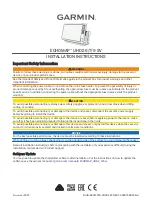
UBX-G7020 - Hardware Integration Manual
Design-in
GPS.G7-HW-10003
Objective Specification
Page 28 of 74
1.
Using a GPS/GNSS live signal: Observe the Clock Drift value inside the UBX-NAV-CLOCK message after
the receiver has acquired a position. Its measurement unit is µs/s which is actually the same as ppm.
2.
Using a 1-channel simulator: Observe the Doppler value inside the UBX-MON-PT message. The crystal
offset in ppm can be calculated by dividing this value by -1575.42 Hz (observe the change in sign).
The following tuning sequence is recommended:
1.
Produce a few sample boards using the starting values for C14 and C15 as provided in Table 34.
2.
Check frequency offset of theses samples using any of the methods mentioned above.
3.
Gently change load capacitor values (increase for lower frequency) until frequency error is minimized.
4.
Using the new values, start pre-series production and observe frequency offset at room temperature
5.
If necessary, adjust capacitor values again.
Initial frequency tolerance of a crystal tends to show low variation across single crystal production lots. This
means that one production lot (several 1000 pieces) can be well centered at 0 ppm offset, while for example the
next lot can come at +5 ppm offset in average. It is therefore highly recommended to monitor crystal frequency
offset continuously in production.
2.4.5
TCXO
The LDO_X_OUT, the clock domain voltage, is used to supply or supervise (enable) the TCXO. Thus it will be
supervised and switched on and off by the firmware, e.g. in Power Save Mode. Any voltage ripple at VDD_IO,
which supplies the LDO_X to generate LDO_X_OUT, is rejected significantly if using LDO_X_OUT to supply a
TCXO. The correct LDO_X_OUT voltage has to be set by Low Level Configuration.
The LDO_X_OUT voltage has to be set by the Low Level Configuration to ensure it matches the supply
voltage range of TCXO! See section 2.10.2.
There are 4 main options when connecting a TCXO; each depends on the VDD_IO voltage and the supply
voltage range of the chosen TCXO. The supply voltage for VDD_IO has to be chosen dependant on the voltage
level needed at the PIO’s to supply e.g. the communication interface, SQI interface etc. Hence the following
table gives information on the configuration and circuit to be used for a given VDD_IO supply voltage and TCXO
supply range combination.
Option
VDD_IO
supply
TCXO
used
LDO_X_OUT
voltage set by
config
Usage
of
LDO_X_OUT
Circuit
Remarks
1
2.0…3.6V
1.8V
1.9V
Supply and enable
of TCXO
Recommended circuit.
2
3.1…3.6V
3V
3.0V
Supply and enable
of TCXO
3
1.65…2.0V
1.8V
1.7V
Enable of TCXO
Supply voltage for VDD_IO has to be used to
supply TCXO. Make sure it is a very clean
and stable voltage.
4
2.7…3.0V
3V
2.7V
Enable of TCXO
Supply voltage for VDD_IO has to be used to
supply TCXO. Make sure it is a very clean
and stable voltage.
Table 9: Options to supply the TCXO
A clean and stable supply voltage is essential for the performance of the TXCO and thus for the GPS/GNSS
performance! So it is recommended to make use of the internal LDO_X regulator to supply the TCXO. If the
LDO_X_OUT voltage is used only to supervise (enable) the TCXO, make sure a clean and stable voltage is
supplied to the TCXO.
A higher voltage drop at LDO_X will improve the ripple rejection from VDD_IO to LDO_X_OUT. Thus it is
recommended to use a 1.8V TCXO in 3V designs; option 1 in Table 9!















































